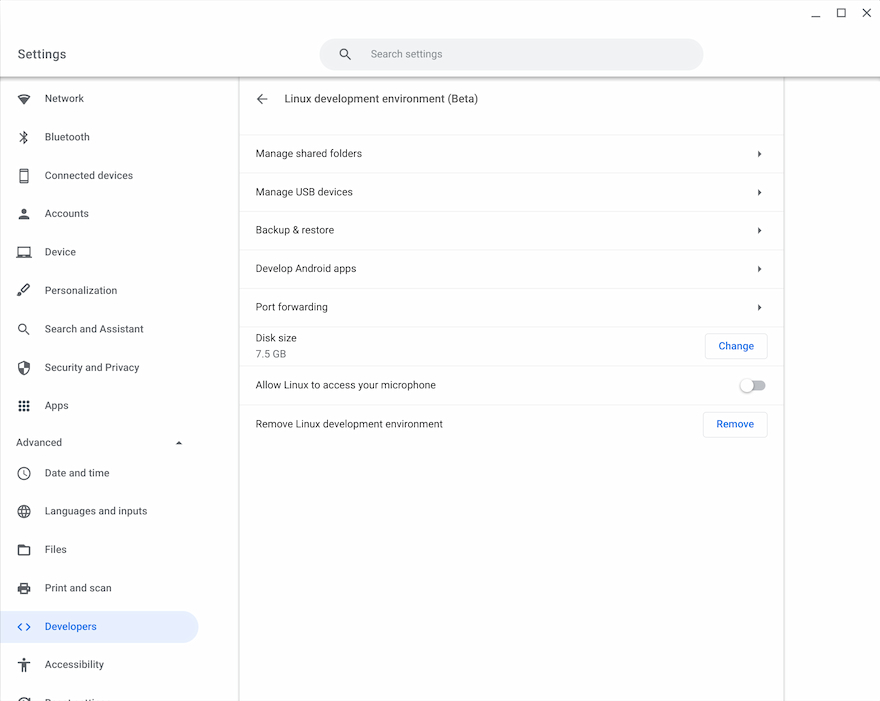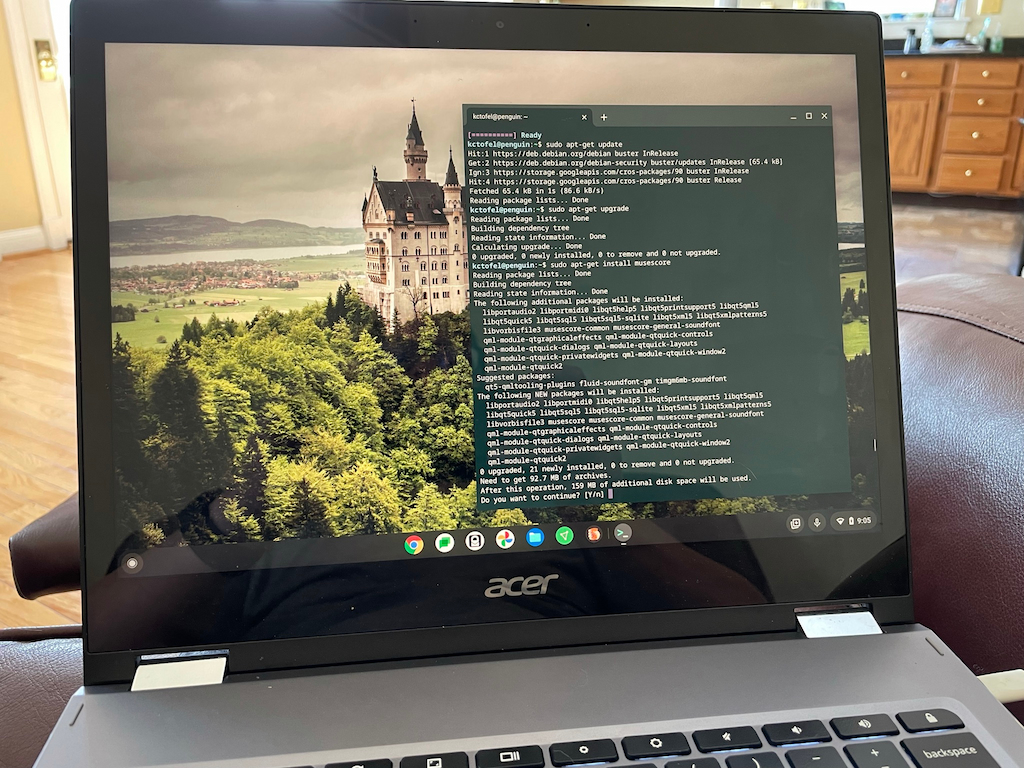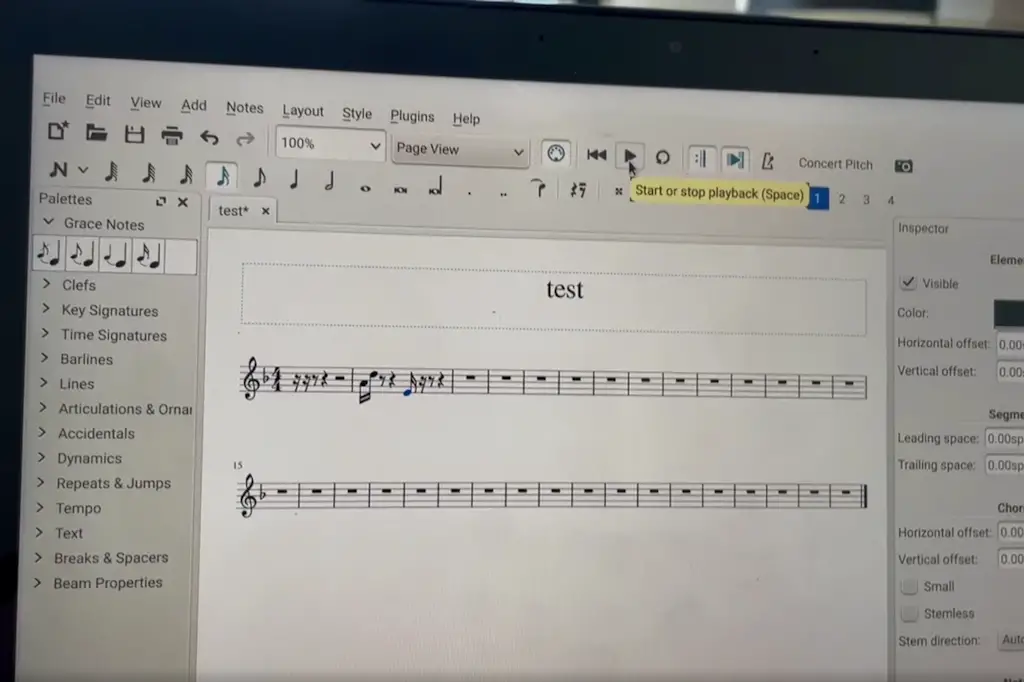I’ve previously written an overview with five reasons to run Linux on Chromebooks, but there are tons of specific examples I could share. One arrived just this morning as one of my former Computer Science teachers reached out, asking if MuseScore could run on a Chromebook.
I had an answer back to her in minutes, along with installation instructions, showing her the versatility of Linux on Chromebooks.
She had done some research and found the old Crouton method of using Linux. While that could work, it’s an old, non-supported dual-boot solution. (Update: Technically, Crouton is supported internally at Google by an employee. However, it’s not supported for end-users by Google itself. And it’s also a “chroot” solution, not dual-boot as I previously noted. Thanks, Pat!)
Instead, I explained that Linux on Chromebooks is natively and officially supported by Google. And it’s easy to install from the Settings in Chrome OS:

MuseScore is a music composition and notation application; not something I’ve used before. But that really doesn’t matter.
I went to the MuseScore website and saw it supports just about every “flavor” of Linux. I opened up the Terminal app on my Chromebook to access the Linux container and typed sudo apt-get install musescore.

After about of minute of downloads and installation messages, I had MuseScore on my Chromebook, complete with a Launcher icon.
Of course, installing a Linux app on a Chromebook doesn’t mean it will work 100% of the time or have full functionality.
I was concerned that MuseScore might not play back sounds, so I did a very quick test by composing my own score. And by “composing my own score”, I mean adding three random notes. 😉
Playback worked fine and now she has a solution for her digital music composition needs, all thanks to Linux on Chromebooks.
Again, there are tons of single-app examples that I could share to exemplify this often underappreciated Chromebook versatility. I use this functionality in my Computer Science coding classes, for example.
But the general idea is the same: Linux apps are a viable option to adding more capabilities to Chrome OS. So don’t be shy about trying them!



17 Comments
Let me say that I always read and enjoy your About Chromebooks articles. I have been a MuseScore user for years. Although you can do the CLI install, there is also an AppImage version of MuseScore.
But your statement that crouton is an “old, non-supported dual-boot solution” us flat out wrong. First off, it is not “dual boot.” Dual boot means that at boot time you must choose one OS or the other. Crouton, like crostini, lives in a container, which in crouton are called “chroots.” Both ChromeOS and Linux are running simultaneously. It is very easy to switch between them. After starting a Linux session, you can use the window switcher key to return to Chrome, and then you can return to Linux with the crouton icon that appears on the task bar when a Linux session is running. This is no more difficult than switching between ChromeOS and Buster under crostini.
The huge advantage of crouton over crostini is that a crouton installation of Ubuntu gives the user a complete graphical desktop, precisely the same as Linux running on a dedicated Linus computer, whereas crostini forces the user to use the command line interface. I tried installing an xfce desktop on crostini, and it is just flaky. Coming from Mac or Windows, the Linux desktop under crouton is much less intimidating. The crouton user experience is far superior to crostini, with the app menu, the file manager, and all the trimimings of a full desktop.
Now as to “old and unsupported.” Crouton has been around for quite a few years – I was an early adopter – and although crouton is largely the work of two individuals, it has always been kept current. Dan Schneider is the Google employee who developed crouton, and he has always promptly addressed issues, such as when Google eliminated the ability to run scripts from the ~/Downloads directory, Dan was right on the spot with the command needed to move the script to the /usr directory, which was then as simple to install as before. It does take one command at the CLI to install whatever version of Linux (mostly Ubuntu but other flavors can be installed as well), but this is very well explained in the Readme. I have Ubuntu 16.04 (xenial), 18.04 (bionic), and 20.04 (focal) installed on several of my Chromebooks, and they all run flawlessly.
Now, that said, Google is always changing something it seems. All my crouton installations were made under ChromeOS 90 or earlier. After upgrading to ChromeOS 91 within the last several days, it seems to have broken the crouton installer, but I trust Dan will fix this as soon as possible. It is still amazing to me that as a purely volunteer project, crouton has supported everything Linux has to offer, including audio, since the beginning, while crostini has only recently been able to handle audio. I think crouton deserves a lot more respect than you seem to give it.
Pat, you are spot on with my inadvertent mistake about the dual-boot reference. Since I haven’t used Crouton since 2018, I forgot it was a chroot solution. I’ll correct that in the article. And while Crouton is a valid solution, it’s not the one I would recommend for mainstream Chromebook users. That would be Crostini, which is built-in as a Chrome OS option and architected to maintain the Chrome OS security that Google advertises. After all, Crouton requires Developer Mode, which at that point, Google can’t guarantee device security. And when I say unsupported, I mean “officially”, as in by Google, not by Dan or any other Google employee. I have nothing but respect for the work Dan has done. But that’s not the long-term, official Google vision for running Linux on Chromebooks, hence my perspective. Cheers!
One quick edit/addition: Even Dan hits this point on the Crouton site, saying “Crostini is an official project within Chromium OS to bring the Linux shell and apps to the platform in verified mode with clean integration, multi-layered security, and all the polish you expect from Chromium OS proper.
That means compared to crouton, Crostini has official support, competent engineers, and code that looks a little less like ramen. crouton, in its defense, has wider device compatibility, enables direct hardware access, and is named after an objectively tastier bread-based food item.”
Crouton sure is nice but….
Anything that makes me enter dev mode is just a no, why break that great security layer.
What happens when Dan gets fed up moves onto something else / retires / gets ill / falls out with Googles lawyers / argues with his tech partner …. these homebrew projects are great but so many of them just don’t last because they rely on too few people. Linux is basically a history of people falling out or moving on when they get bored. The amount of man hours put into Linux compared to actual lasting output is hilarious.
Yeah there are plenty of specific examples and probably plenty of people missing out because they don’t know.
Off course on Windows everyone would just “know” these specialist areas are possible.
So we have come full circle with Chrome OS and it can’t do 100% of things. Google should really jump on this and make a Linux App store, Linux apps are just better than Playstore. Make the Linux tech more user friendly and professional, then market it well. If they did a Linux version of Google docs, it would really put the squeeze on Microsoft. It would mabye take away from their focus on PWAs a little, but no major harm attacking Microsoft on their own turf for a while too. Squeeze the competition from both angles, I don’t see why not.
I wish that there was a good way for users to induce/coerce developers into moving their locally installed applications to Web apps. Even when a perfectly functional Web app exists, the developer will still usually overtly prefer the installed, non-Web app version of the application and strongly encourage the user to do the same. Microsoft does this when I use TEAMS on Win10. And Google does this by consistently defaulting to Android apps when they’re installed on Chrome OS.
I disagree about moving everything to web apps. When I am out on my boat or traveling in my camper, I am frequently without an internet connection. Local programs in Linux let me do most of what I use a computer for other than email or web browing. For example, LibreOffice alone is is worth having offline. But there are many others as well.
PWA standard now insists on offline capability. Gmail, GDocs, Ddrive all work offline. There’s even a toggle to practice offline mode.
“Moving” of course means simply creating that as an equivalent alternative, not replacing as your post implies. Even when I use Win10, I prefer working as much as possible in browser tabs. The less that’s installed locally, the better the device performs, in my experience.
The only really “insecure” part of developer mode is that anyone AT THE KEYBOARD of your Chromebook will have root access, and can alter system files or install evil software. It is not more vulnerable to online hacks in developer mode. Now, if YOU install third party software in developer mode that has exploits in it, too bad for you. This is USER insecurity, not Chromebook insecurity! So unless you are worried about someone gaining physical access to your Chromebook, you do not need to worry about using developer mode. Just don’t leave your Chromebook on the table at Starbucks when you go to the bathroom!
https://www.quora.com/Would-enabling-developer-mode-in-Chromebook-render-it-vulnerable-to-wireless-attacks?share=1
Linux is a good differentiator today, but may not be for much longer. The history of PC tech is “if you build it and they come, then Microsoft will eventually appropriate it”.
While you may not like them, you can’t dispute its ability to appropriate literally everything, and they have set their sights on Chromebooks. They don’t need to be better, or as good in any way, just good enough.
With Chromium as the basis of its browser, Chrome apps and web apps can be run under Windows now.
Google countered with promised Windows program-running ability, severely limited by hardware resources.
Microsoft countered with Android apps coming to Windows 11.
Hardware resources is the biggest restriction on Chromebooks used as multi-OS platforms. If used primarily to run Windows programs, Chromebooks cannot compete on a retail cost of hardware basis with a Windows PC, but a typical Windows PC of 5 years ago has more than enough spare hardware resources to easily house and run web and Android apps today.
It looks like Google is getting ready to re-position if, not phase out, the Chromebook platform as a specialty appliance for specific target markers as it did Android tablets. IMO the only reason Google bought CloudReady was to be able to utilize lower cost higher volume general PC platforms that have more resources than Chromebooks do.
If Microsoft replaces its kernel with some -IX variant, Google’s only advantage over Microsoft would be time to respond to new software problems. Security is a technical advantage, but the continued acceptance of Windows baked-in bugs and security flaws indicates to me that most business still don’t understand that security is a significant issue that can’t be provided by grafted on bandaids and backups.
Google’s main disadvantage would remain the same. It does not listen to or communicate (bidirectional) with its users. t makes sermngly randm changes, with no clear goal kin sight and at a very fast rate.
The exponential growth of ransomware and when it hits a major bank will make people think or cry depending on how many bank records get lost. Or a nuclear incident.
Youngsters using Chromebooks will change things as they did the phone market.
A consumer OS that’s as safe and easy to use as a tv will win.
Stadia has showed anything can be clouded, Google should cloud Windows add that extra bit to Chromebooks, but little by little eliminate the need for it, kill Microsoft by using it’s own software against them. They can also do that via Linux as most software is developed there.
No sane person ever chose to use Windows, they were forced by the monopoly. The need for that monopoly has gone now that everything can be done in Chrome i.e the same reason you say Microsoft have made a come back. Microsoft’s strength only now lies in being Chromes slave, they have no say in their own future. Tick tock it’s only a matter of time before people wake up to that and go for the cheaper options, easier, secure, quicker options. If they don’t choose better then they can enjoy paying for Bills divorce.
Flat.io is also a very capable online notation suite, though it’s probably not quite as powerful as MuseScore (at least the free version isn’t).
I don’t get Linux. I just installed Textmaker for Linux on my Pixelbook Go. OK it does access Google Drive, but you then have to search for documents under mnt/chromeos. Most people will not get this. They are used to the ease of Windows going through directories in the file explorer, not searching for obscure directories in a tree full of obscure sounding names.
Sorry – Linux has come a long way, maybe it is secure and wonderful, but it doesn’t look like it and for most people it is a real turn off, including me.
Completely understand where you’re coming from. And to get the full value of Linux on a Chromebook requires a comfort level and experience with Linux. For example, there are dozens of graphical File Managers available to provide a more familiar GUI in the situation you described. Nautilus, Thunar and others are a single command away from installation.
I stopped using the Linux container for various reasons, e.g.
I wanted to use Firefox but internet access was restricted (eg no downloads),
I wanted to use LibreOffice but the graphics were all over the place and I clearly needed to research and install a graphical interface to manage it – more time than I had available!
I wanted to be able to read/write USB sticks but could only do that via Chrome OS Files
The Linux container affected my storage as well as my memory and my Chromebook. In fact I’ve only got 3.6Gb available now so I’ll need to prune my file storage anyway (I download far too much)
The basic Chromebook functions have got steadily better. Files is an excellent no-fuss file manager and Android stability has improved enormously. But I didn’t expect to be relying on Android apps when I got the Chromebook, I thought I’d be relying on Linux!
It’s some time since I tried the Linux container and it probably has got better, and certainly there will be more write-ups to help use it effectively. But I think it will take a better resourced chromebook than mine, Acer A481T (which I like) (4 Gb RAM but only 30Gb available for file storage) and for the cost of that new I’d rather buy a new Linux-installed laptop.
So, sounded a great feature, but frustrations all round really!
I have a question about Linux. I have a Dell Chromebook OS Laptop and I want to use a DVD/CD player extension .I read in the instructions to the DVD/CD player that I need to download software to use it. I also saw that I could use Linux to use this device. Do you have any information on this, or how I can download this. Do I just go to Google and type in the Linux app or is there a software link I can type in or how do I go about doing this. Also will the software damage my Chromebook if used? If you have any advice I would appreciate it so much. I’m new to Chromebooks and I need help using them. Do you know howl I can get a manual for this Chromebook or are there any videos you can suggest like from YouTube.
My model # is XDGJH. It’s Dell Chromebook Laptop N2840.
I’m not certain that your Dell model even supports Linux to be honest. Based on the information you provided, it’s quite an old Chromebook and possibly with 2 GB of memory which won’t be enough. Best way to check: Go into Settings on your Chromebook and look in the Advanced menu options. Look to see if there’s a Developers or Linux option there. If so, you essentially just enable Linux. If not, you’re out of luck. Let’s start there before going through installation of any Linux apps. Cheers!